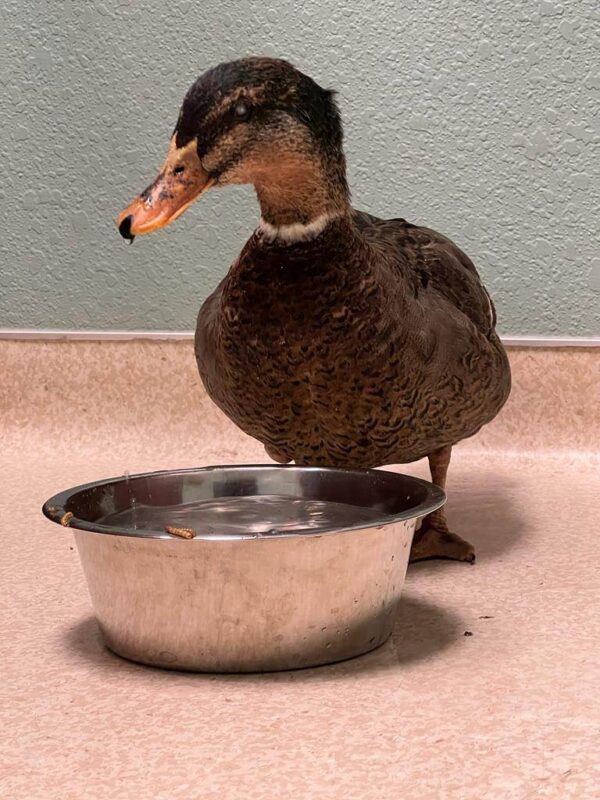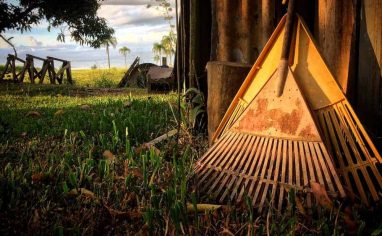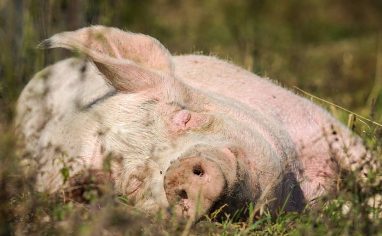
This resource was updated in preparation for veterinary review. It was originally published on July 18, 2018.

Veterinary Review Initiative
This resource has been reviewed for accuracy and clarity by a qualified Doctor of Veterinary Medicine with farmed animal sanctuaryAn animal sanctuary that primarily cares for rescued animals that were farmed by humans. experience as of June 2025.
Check out more information on our Veterinary Review Initiative here!
With proper care, ducksUnless explicitly mentioned, we are referring to domesticated duck breeds, not wild ducks, who may have unique needs not covered by this resource. have the opportunity to live long lives. While there is variation by breed, the average life expectancy for a domesticatedAdapted over time (as by selective breeding) from a wild or natural state to life in close association with and to the benefit of humans duckUnless explicitly mentioned, we are referring to domesticated duck breeds, not wild ducks, who may have unique needs not covered by this resource. ranges from 8-15 years, with some individuals living well beyond that! There are many factors that affect an individual’s expected lifespan, including some that are beyond a caregiver’s control, such as their breed, genetics, and health status upon arrival, but their environment, as well as the nutrition and care they receive after rescue, factor in as well. In addition to having an impact on their life expectancy, these elements of care also affect their quality of life and can help them thrive in old age!
Health Care Considerations For Older Ducks
Thoughtful observation, routine health checks, and regular veterinary care are essential for all residents. However, you may find that older residents benefit from more frequent assessments and closer observation than they did when they were younger. This can help you catch and respond to issues before they progress to more serious concerns. Some conditions, such as mobility issues, tend to be quite common in older ducks, and reproductive issues are common in certain breeds, though these are certainly not the only conditions that can affect older residents (and these conditions are not exclusive to older residents either). By keeping a closer eye on older residents, you’ll be better able to catch signs of new or worsening conditions as soon as possible!
Daily Observation And Routine Health Checks
During daily observation and routine health checks, you should watch closely for any signs of concern, but when it comes to older ducks, there are a few areas that may warrant extra attention.
Watch For Signs Of Arthritis And Related Issues
First, because osteoarthritis (degenerative joint disease) is common in elderly animals, it’s important to closely monitor older duck residents for signs of this condition, which include an abnormal gaitA specific way of moving and the rhythmic patterns of hooves and legs. Gaits are natural (walking, trotting, galloping) or acquired meaning humans have had a hand in changing their gaits for "sport"., bearing weight unevenly when standing, lameness, using their wings for support, and reduced activity. You may also be able to hear or feel crepitus (grating or crunching) in the hock1: the tarsal joint or region in the hind limb of a digitigrade quadruped (such as the horse) corresponding to the human ankle but elevated and bending backward 2: a joint of a fowl's leg that corresponds to the hock of a quadruped (this can be more difficult to feel in the knee and hip). If you notice signs of osteoarthritis, be sure to work closely with your veterinarian–proper pain management is imperative for individuals with painful conditions, and we’ll talk more about this below. It’s important to note that ducks can also develop septic arthritis (infectious arthritis), which would require the addition of an antimicrobial treatment, as prescribed by your veterinarian.
Individuals with arthritis may develop issues secondary to their mobility issues. Residents who spend more time lying down are at an increased risk of developing pressure sores on their hocks and keel. Pressure sores can become more difficult to manage if not addressed early on, so it’s a good idea to pay close attention to their hocks and keel, checking for changes to the appearance of the skin or the development of scabs or open sores. Keep in mind that keel sores may not be visible without parting their feathers. We’ll discuss environmental changes that can help prevent the development of pressure sores in the living spaceThe indoor or outdoor area where an animal resident lives, eats, and rests. section below.
Individuals with osteoarthritis or other mobility issues may use their wings to help support themselves while walking and standing, which can lead to battered wing feathers and abrasions to the skin. In addition to watching how they move, also pay close attention to their wing tips, looking for signs that they may be using their wings for support. As with pressure sores, environmental modification can help protect wing tips from damage.
Caring For Individuals With Severe Mobility Issues
If an individual develops a mobility issue that makes it difficult or impossible for them to walk unassisted, you might consider whether they would benefit from using a device such as a therapy chair, cart, or homemade sling. While not every individual will tolerate or benefit from devices such as these, for others, these devices can give individuals who are otherwise unable to walk or stand the support they need to do so. Depending on the situation and the individual, this may give them more autonomyThe ability for individuals to have access to free movement, appropriate food, and the ability to reasonably avoid situations they wish to avoid. and can also help prevent the development of hock and keel sores (though you would want to watch carefully that they are not developing sores in areas where their body makes contact with the device). Individuals using supportive devices, particularly carts, may need further modification to their living space beyond those described in this resource. You’ll want to avoid obstacles and terrain that could cause them to tip or become stuck, and they should not be left unattended while near open water sources (though, if they enjoy swimming and are still physically able to do so, it’s important to still give them plenty of opportunities to swim–swimming is a natural waterfowl activity and also can take pressure off achy joints). We recommend very close observation of residents using these devices so that you can respond immediately to any issues that may arise.
Pay Close Attention To Their Feet
As your duck residents age, their foot webbing may dry out a bit, becoming less supple and more prone to damage. This, combined with the fact that older residents may be picking up their feet less or even dragging their feet, can make their feet more prone to abrasions. It’s important to keep a close eye on your residents’ feet so that you can address issues early (which may also include making changes to their living spaces, which we’ll describe more below).
We recommend paying close attention to all older residents’ feet, but individuals with mobility issues may need even closer attention because they are at an increased risk of developing bumblefoot. Individuals who favor one foot over the other due to pain or a mechanical leg issue may develop bumblefoot on their “good” side. Because this foot has to bear more weight, the skin can become damaged over time. Without proper interventions, bumblefoot can progress from a minor issue to something far more severe. The prognosis is best when addressed early, so be sure to contact your veterinarian if you see signs of bumblefoot. You can read more about the stages of bumblefoot here.
Residents who bear weight unevenly or who are less active than they previously were may also need some or all of their nails trimmed more often than they previously did. If you find that an individual’s nails are becoming too overgrown between regularly scheduled nail trims, you’ll need to put them on their own schedule.
Pay Close Attention To Their Rear End
When observing older duck residents, you should also pay extra attention to the area around their vent. Arthritic individuals may have a harder time keeping themselves clean, especially if they are not swimming regularly. As a result, they may develop fecal matting under and around their vent. It’s important to note that fecal matting could also be due to an underlying health condition (such as a gastrointestinal or reproductive illness), so if one of your residents has severe or ongoing fecal matting, we always recommend checking in with your veterinarian to make sure there is not another issue going on. Mild fecal matting may be able to be cleaned with a wet cloth, but individuals with severe and/or ongoing fecal matting may benefit from regular time swimming or standing in a water bath (but never with soap, which can remove their feathers’ natural waterproofing). Be aware that different individuals may have different preferences in terms of the water level they prefer to preen in, so observe them closely and adjust the level as needed. If they need help drying off, you can use a blow dryer on a low-heat setting. Do not use blow dryers that contain polytetrafluoroethylene (PTFE, also known by the brand name Teflon), as this can expose them to highly toxic fumes.
Closely Monitor Their Weight
It’s also very important to pay close attention to your older duck residents’ weight. We recommend regularly monitoring all of your duck residents’ weight and body condition (at least at every health checkThe Open Sanctuary Project uses the term "health check" to describe health evaluations performed by caregivers who are not licensed veterinarians. While regular health checks are an important part of animal care, they are not meant to be a replacement for a physical exam performed by a licensed veterinarian.), but you may find that older individuals benefit from more frequent evaluation so that you can catch weight changes before they become drastic. Both weight loss and weight gain can be signs of an underlying concern that needs to be addressed, and both can predispose them to other health issues (we’ll talk about this a bit more in the diet section). Unexplained weight loss could have a number of causes, including certain diseases, mobility issues, and/or unhealthy social dynamics. If you notice that a resident has lost weight or muscle mass, be sure to have them evaluated by a veterinarian. In addition to a physical exam, diagnostics such as fecal testing to screen for internal parasites and blood work are recommended.
“Old Age” Is Not A Diagnosis
Unexplained weight loss should always be a red flag and should be investigated–don’t just chalk it up to “old age.” Be sure to work with your veterinarian to diagnose and, if possible, treat (or manage) any underlying health conditions your older residents are dealing with. If diet changes are in order, your veterinarian or an avian nutritionist will be able to make recommendations based on the specific needs of the individual.
While weight loss can be an issue in older ducks, unhealthy weight gain can also be an issue. Individuals who previously maintained a healthy weight on their standard diet may become overweight if their activity level decreases, which can be common in older individuals, particularly those with mobility issues. While any duck resident can become overweight if they are eating more calories, protein, and/or fat than they need, some breeds, such as Pekins and Moulards, are more likely to deal with this issue than others. Unhealthy weight gain can predispose an individual to other issues such as arthritis, bumblefoot, and cardiovascular issues, so if you notice that a resident’s weight is creeping up, you’ll want to talk to your veterinarian about how to keep them in a healthy weight range.
Monitoring Your Residents’ Quality Of Life
An important aspect of animal care, generally, and particularly elder care, entails closely monitoring an individual’s quality of life and having a plan in place if euthanasia is deemed necessary. While some residents pass away peacefully in their sleep without first showing a significant decrease in their quality of life, this is unusual. More often, older residents will develop chronic and progressive issues, such as osteoarthritis or cancer, that progress to the point where you, the caregiving team, or your veterinarian feel euthanasiaThe act of ending someone’s life to spare them from suffering or a significantly reduced quality of life that cannot be managed. should be considered. These can be very difficult decisions to make, regardless of one’s experience level. To avoid making an already difficult situation even more difficult, it can be helpful to craft a euthanasia policy that you discuss with your veterinarian well before you are in a position where euthanasia must be considered. To help with this difficult process, please check out our veterinarian-reviewed Model Euthanasia Policy.
Veterinary Care
We recommend asking your veterinarian how frequently they think your older duck residents should be seen (ideally, at least twice a year). Individuals with ongoing issues that require monitoring may need to be seen more often than those without health issues, but even for apparently healthy individuals, more frequent vet visits may be in order (plus diagnostics to screen for disease, as recommended by your veterinarian).
Pain Management For Individuals With Arthritis
Osteoarthritis is one of the most common health concerns in older animals, and ducks are no exception. Ducks of all sizes can develop osteoarthritis, and there are various factors that contribute to the onset and severity of the disease. However, heavier individuals are at an increased risk–this includes bigger breeds (such as Pekin, Moulard, and Muscovy ducks), as well as individuals who are overweight. This is one of many reasons why weight management is so important, particularly in breeds that are prone to unhealthy weight gain.
Without pain management, osteoarthritis can cause chronic pain (ranging in severity from mild to debilitating) and can affect an individual’s activity level and quality of life. Severe pain can result in a general reluctance or even the inability to walk (putting them at risk of developing pressure sores). While there is no cure for osteoarthritis, and it is a progressive condition (meaning it worsens over time), there are medications that can help alleviate an individual’s pain. If one of your residents is showing signs of lameness, pain, and/or decreased activity, be sure to work with your veterinarian to diagnose and treat the issue.
All Arthritis Solutions MUST Be Discussed With Your Veterinarian!
Below, we’ll discuss some specific medications and supplements that might be incorporated into an individual’s treatment plan. However, any time you wish to explore arthritis management options, even those that do not require a prescription, you must have a conversation with your veterinarian! Arthritis can be a complex issue, and an individual’s health or other treatments may make certain treatments ill-advised!
While there are currently no non-steroidal anti-inflammatory drugs (NSAIDs) approved for use in ducks, your veterinarian may prescribe extra-labelExtra-label use means that a drug is used in a way other than what is described on the label or package insert. If a drug is used in a different species than what it has been approved for, this is extra-label use. Other examples include using a drug to treat a different condition than it is approved for or administering it in a different way than the directions describe. Extra-label drug use can only occur within the confines of a valid veterinarian-client-patient relationship. use of an NSAID such as meloxicam or carprofen. NSAID treatment should never be combined with other NSAIDs, and in some individuals, NSAID use may be contraindicated (not advised). If your veterinarian deems NSAID use to be contraindicated or determines that the individual needs additional pain relief, they may prescribe other analgesics such as tramadol (a controlled opioid) and/or gabapentin, instead of or in addition to an NSAID. Be aware that commercially available gabapentin oral solutions contain xylitol and should not be used in birds.
Anecdotally, adjunctive therapies such as cold laser therapy and acupuncture, as well as the use of a chondroprotective agent such as Adequan, have helped keep arthritic avian residents comfortable. Some sanctuaries have also seen some success by combining conventional medications with more natural remedies such as Boswellia serrata (also known as Indian Frankincense), capsicum, turmeric, and/or CBDA non-hallucinogenic substance from the hemp plant. Some claim that it can help manage pain and certain health conditions in animals, though there is little research in this field. Because CBD is not highly regulated, it can be difficult to ascertain exactly how pure any CBD oil or supplement may actually be. Some suggest that CBD oil, if ingested by ruminants, can cause harm to rumens. oil. Be sure to talk to your veterinarian about the most appropriate pain management regimen for each of your residents. While you may be able to obtain supplements without a veterinarian’s prescription, some of these may have adverse effects in individuals or negatively interact with current medications. It is very important to consult with your veterinarian prior to starting any supplements. They can determine what is most appropriate based on various factors pertaining to the individual and any other treatments they are on, as well as the latest scientific evidence available.
In addition to talking to your veterinarian about the most appropriate pain management regimen for each of your residents, be sure to ask them about conducting blood work before certain treatments (such as NSAID treatment) to ensure the treatment is not contraindicated and to establish a baseline against which future blood work results can be compared. We also recommend asking them about conducting regular blood work for individuals on certain long-term treatments (including NSAID treatment) to monitor organ function and watch for adverse effects.
Individuals with osteoarthritis may also benefit from environmental modifications, as described later on in this resource. Ongoing assessment of arthritic residents is imperative. As the condition progresses, you may find that their pain management plan needs to be re-evaluated, and you’ll want to have ongoing discussions about their quality of life (with other caregivers as well as with your veterinarian). You’ll also want to be on the lookout for signs of secondary issues such as bumblefoot and pressure sores.
Living Space Considerations For Older Ducks
While some older duck residents may continue to do well without any changes to their living spaces, others may require certain modifications to help keep them safe and comfortable.
Indoor Living Space Considerations For Older Ducks
It’s important to monitor an older resident’s indoor living space to ensure it keeps them comfortable and is free of any hazards that could cause injury. Be sure to consider the following when evaluating an older duck resident’s indoor living space:
Flooring
When evaluating your residents’ flooring, keep in mind that older ducks may need better traction and more cushion than they previously did. Additionally, changes to their mobility may necessitate certain modifications. Depending on the type of flooring present in their indoor space, you may find that covering the floor with thick textured floor mats (such as interlocking foam floor mats) or adding a deep layer of dirt or sand can help provide residents with a bit more traction and can also protect their delicate feet from abrasive flooring. While dirt flooring may be easier on the joints, remember that all housing modification must be done with predator-proofing in mind–an earthen floor can be dug through by predators and will need to be used in conjunction with other materials to keep residents safe.
The addition of textured floor mats, dirt, or sand can also add a bit more cushioning for feet and joints, though to different degrees. Packed dirt can become very hard, providing less cushion than sand or more loosely packed dirt. Floor mats come in many varieties with differing thicknesses and provide different degrees of cushioning. Individuals with painful mobility issues or who spend more time lying down may benefit from thicker, softer mats to provide more cushioning to their feet and joints and to help prevent pressure sores if they are spending more time lying down. While the additional cushioning can be helpful, you must make sure it does not impede their ability to walk. A pillowy floor mat may be wonderful to lie down on, but walking across a substrate with that much give might be a challenge. Therefore, you may opt to add a certain amount of cushioning to the entire space, plus extra cushioning in the area in which the individual typically sleeps or relaxes during the day.
The substrate your duck residents walk on should be relatively flat and even. Be sure to watch for and quickly address any unevenness and trip hazards. Dirt floors are prone to developing divots over time, and these divots can result in injury. Similarly, floor mats that do not lie flat against the floor can cause a resident to trip. Doorways/thresholds are a common trip hazard, which we will discuss more below.
Bedding
Just as previously suitable flooring may need modifications in order to ensure older residents have ample traction and cushion and to prevent damage to their feet, you may also need to make changes to the type and/or amount of bedding used in their living space for similar reasons. Individuals who are less active and spend more time lying down may require extra bedding material to prevent pressure sores from developing on their hocks and keel (or to prevent sores that have developed from getting worse).
While straw is a common bedding option, there are numerous reasons why some folks choose not to use it for their bird residents, regardless of their age (one reason being the increased risk of aspergillosis). Even if you decide that straw is an appropriate option for your duck residents, generally, you may find that it is not the best option for older residents. First, a thick layer of straw can be more difficult to walk through than some other options, such as pine or aspen wood shavings or hemp bedding. Second, there are many types of straw, each with its own characteristics in terms of absorbency, softness, and the traction they provide, and even when comparing bales of the same type of straw, there can be variations in fiber length. If you decide to use straw, opt for one that is absorbent and soft. While this is best for all duck residents, tough, stalky straw may be more likely to cause damage or irritation to an older resident who has more delicate foot webbing or who drags their feet while walking. Speaking of dragging their feet, individuals who do this may become tangled in long-fibered straw, making it even more difficult for them to walk. Switching to a short-fibered straw or another type of bedding entirely can prevent this issue.
Doorways
Another element of the living space that warrants a closer look is doorways and thresholds. Even a slightly raised threshold could pose a tripping hazard or could injure a resident who doesn’t fully pick up their feet. This can prove even more dangerous if there is also a step down on one side of the threshold (such as in an elevated doorway that leads to the outdoors). Whenever possible, avoid raised thresholds. If this is not possible, make sure the threshold has the lowest profile possible and that it is free of sharp or rough edges that may cause damage to the feet.
Similarly, avoid layouts where residents need to jump up or down to move between their indoor and outdoor spaces. While a wide, gently-sloped ramp may work fine for other duck residents, older residents may struggle to navigate even a slight grade, and, depending on the material the ramp is made of, there may be traction issues or risk of damage to their feet. While it’s important to avoid a negative slope around resident housing in order to keep spaces dry, you also want to make sure your residents are able to move between their indoor and outdoor spaces with ease. It’s best to keep entrances as close to ground level as possible. To make it easier for residents to come and go, consider building up the earth around the entryway to create a wide, gentle slope. If you must provide a ramp, keep these very gently inclined and make sure they are wide to prevent residents from falling or jumping off.
Roosts
While most domesticated ducks sleep and relax at ground level, Muscovies typically choose to sleep up off the ground when given the opportunity. While it’s important to understand and honor their natural behaviors, it’s also important to consider the impact flying or jumping down from a high roost could have on a resident’s legs. Given their large size, male Muscovies, in particular, could injure themselves while jumping or flying down from a high roost, especially if they land on hard or slippery flooring. It’s best to keep roosts low and to ensure that the area surrounding the roost provides ample traction and cushion to ensure a safe landing.
Temperature Considerations
While it’s important to provide safe heating and cooling as necessary for all duck residents, you may find that as individuals age, the temperature range they can tolerate becomes narrow. Be sure to closely observe older residents for signs they are too hot (open-mouth breathing and holding wings away from their body) or too cold (puffed-up feathers) and take steps to keep them comfortable. You’ll also need to take preventative measures to keep them safe and comfy when extreme temperatures are in the forecast.
Outdoor Living Space Considerations For Older Ducks
As ducks age, their activity level may decrease, especially if they have arthritis or another health condition that affects their mobility or stamina. Depending on the type of outdoor space they have access to, certain modifications may be in order. Just as their indoor space should be easy to navigate with flat terrain, so too should their outdoor space. Rocky or hilly terrain could be difficult for them to navigate. While you don’t necessarily need to move older residents into smaller outdoor spaces (though some may benefit from this), it’s a good idea to keep important resources within a close distance so that they do not have to travel far if they don’t want to or are unable to. Food and drinking water should absolutely be placed in areas where they can easily access them without having to travel too far or navigate difficult terrain, and they should also have easy access to different types of spaces, such as a nice shady area in which to nap, tasty vegetation to graze upon, and water in which to bathe and swim.
Bathing And Swimming Water
While access to bathing and swimming water is a must for all waterfowl residents, safely providing swimming/bathing opportunities to older residents, particularly those with mobility issues, requires extra attention. In addition to making sure older residents have close and easy access to a swimming area, you also must make sure that they are able to get in and out with ease. Steep grades (in or out of the water) can be difficult for older residents to navigate. If using a kiddie pool or large trough, it’s a good idea to turn these into in-ground pools by digging out the earth and positioning them so that they are just about level with the surrounding ground. This can make it much easier for residents to get into the water (rather than having to navigate a ramp). Similarly, if residents have a pond in their outdoor space, consider how easily older residents can access it. If you are in the design phase of waterfowl housing, try to create a space that allows residents to access the pond without having to navigate difficult terrain, which could result in injury or simply discourage them from making the journey to the pond. We realize you can’t exactly change the location of established ponds or snap your fingers and change the terrain surrounding it, but if you notice residents are having a hard time accessing their pond, you can help address the situation by either moving them to a different living space that has more appropriate terrain, or you can provide additional swimming areas (such as adding a kiddie pool) in areas that are easier for them to access.
In addition to considering how easily your residents can access and get into swimming water, also pay extra attention to how easily residents can get out of the water. While younger individuals may have no issues, you may find that older residents struggle, depending on your setup. Pools and troughs with upright sides could pose a challenge to older residents (and sometimes other residents as well). Placing large, smooth rocks in the water where residents exit can help make things easier. Depending on the size of the rocks and the depth of the water, you may need to carefully pile rocks on top of each other to create a gently sloped ramp leading out of the water. These rocks should be cleaned when the pool is cleaned–they can become very slimy and slippery, making them difficult for residents to use.
When digging a pond for residents, avoid designing it in a way that creates a sudden drop-off into the water from the shore. A gentle slope is better. Not only will this make it easier for residents of all ages to get in and out, but the shallow water along the shore can be a popular spot for residents who just want to splash a bit.
Diet Considerations For Older Ducks
Providing your duck residents with a healthy diet is important at every stage of their lives, including in old age. Some ducks may continue to thrive on the standard diet you provide to other mature duck residents (remember, ducklings have different nutritional requirements), but others may need modifications made to their diet or to the way their food is provided. If your female residents are typically fed a diet higher in calcium to support the demands of egg-laying, keep in mind that this is more calcium than they require after they have stopped laying eggs. Additionally, individuals with certain health issues may require specific modifications as recommended by your veterinarian.
Since osteoarthritis is a common issue in older residents, some sanctuaries give them supplements, such as turmeric or omega-3 fatty acids, that are thought to help reduce inflammation even if residents are not currently showing signs of arthritis. If this is something you’re interested in doing, we recommend consulting with your veterinarian for guidance.
In this section, we’ll be focusing on some basic modifications that may be beneficial for some older residents, but please keep in mind that you should always consult with your veterinarian when considering diet changes. Also, remember to always consult with your veterinarian in cases of unexplained weight loss.
Avoid Unhealthy Weight Gain
If an older resident has gained an unhealthy amount of weight, you’ll want to make changes to their diet to help them maintain a healthier weight. As mentioned earlier, excess weight can predispose individuals to a host of health issues and can also exacerbate existing conditions. Depending on what you are currently feeding, your veterinarian may recommend switching to a food formula that is lower in protein. If residents are free-fed, your veterinarian may suggest offering measured portions instead of free-choice access. Some breeds are more prone to unhealthy weight gain, but a decrease in activity level can also be a contributing factor. While it may not be unusual for older residents to slow down a bit, painful conditions like osteoarthritis can also cause individuals to be significantly less active. Be sure to work with your veterinarian to implement an appropriate pain management plan for residents who need it.
Pay Attention To How And Where Food Is Provided
When feeding older residents, it’s important to consider where food is offered and how it is provided. This is especially true for individuals with mobility issues, such as those caused by osteoarthritis or an injury, who might be reluctant (or even unable) to access food and water dishes they previously accessed with ease. Appropriate pain management (as described above) is key, but residents may also benefit from certain modifications to where and how the food is provided. Even if an older individual is not particularly painful, they may still have difficulty accessing food due to a disability and/or decreased activity levels. In general, you should plan on placing food and water dishes close to where older residents spend their time (ideally offering multiple dishes in different locations). In some cases, you may need to move food and water dishes throughout the day to ensure continued access as residents move to different areas of their living space.
In addition to the location in which food and drinking water are placed, also consider the kind of food and water containers you are using. Individuals with achy or weak legs may prefer to eat while sitting down, which may not be possible if their food dish is deep with tall sides. You may find that switching to a wider, shallower dish makes it possible for individuals to eat while sitting. Similarly, drinking water provided in a bucket is great for dunking their heads and keeping their nareseither of the pair of openings of the nose or nasal cavity and faces clean, but buckets can be harder for some older residents to access. Consider also providing a dish of water they can drink from while lying down.
While some older residents may do better with the modifications described above, others may require something different. For example, you may find that some individuals actually benefit from having their food and water elevated so that they don’t have to reach down to eat and drink. Be sure to closely observe each individual to determine what modifications they need to eat and drink with ease. Consider providing different options and observing which they seem to prefer.
Pay Attention To How Social Dynamics Factor In
As individuals age, social dynamics sometimes change, and their place in the pecking order may fall. While you should always pay close attention to social dynamics and make adjustments as needed, be sure to pay extra attention to social dynamics when food is involved. If older residents are getting crowded out or bullied by flock mates, they may not get their fair share of food and could start losing weight. If bullying is an issue, it may be necessary to move the individual and their closest companion(s) to their own space, as described below. If the issue is simply that the individual is getting crowded out or seems unable or unwilling to compete with others for food, a few simple adjustments may resolve the issue. First, be sure to offer enough food dishes for everyone to eat comfortably, ideally keeping these dishes spread out so that individuals who want to stay away from others can do so. If this doesn’t seem to be enough, giving the individual time throughout the day to eat away from their flock mates may be beneficial. For example, when food is first put down in the morning, you might separate the individual (and perhaps their closest companion) so that they can have easy access to food with minimal to no competition while the rest of the flock eats in a different part of the living space. If necessary, you could also schedule a few other times during the day to separate them with food to ensure they have plenty of time to eat undisturbed.
Social Considerations For Older Ducks
Ducks are social animals who form strong bonds with their flock mates. However, as duck residents age, you may find that social groupings that previously worked no longer do. If one of your older residents is getting bullied or requires modifications that cannot be accommodated in their current living situation, you may need to consider separating them from their flock. This should be done with great care–isolationIn medical and health-related circumstances, isolation represents the act or policy of separating an individual with a contagious health condition from other residents in order to prevent the spread of disease. In non-medical circumstances, isolation represents the act of preventing an individual from being near their companions due to forced separation. Forcibly isolating an individual to live alone and apart from their companions can result in boredom, loneliness, anxiety, and distress. from their companions can cause ducks of all ages significant distress.
If you need to separate one of your older duck residents from a larger flock, you’ll want to ensure that they can live with at least one of their companions (ideally, their closest companion). While some ducks may prefer to live in a pair, others may prefer living in a smaller flock with a few close companions. We recommend closely observing group dynamics to determine what is best. After separating individuals, be sure to watch for signs of distress, which may indicate that you have inadvertently separated individuals who are strongly bonded.
In addition to considering social bonds, you’ll also want to keep safety in mind. While overmounting is an issue regardless of an individual’s age, older females with mobility issues could be injured by what would otherwise be considered “normal” mounting behavior. They may need to live away from males entirely or, depending on the breeds you care for, may need to live only with males who are much smaller than them. Similarly, you’ll want to watch that older males are not getting bullied by other males, particularly during the spring when hormonal changes may lead to more altercations.
While it may seem like a lot of additional considerations, it’s important to be aware of how an older duck resident’s needs may change as they age and ways in which you can meet those needs. A little extra consideration can go a long way in keeping older residents comfortable and content despite some of the challenges that can come with old age!
SOURCES:
Pain Management In The Avian Patient | Improve Veterinary Practice
Pain Management For The Avian Patient | Thomas N. Tully, Jr., DVM, MS, DABVP (Avian), DECZM (Avian)








